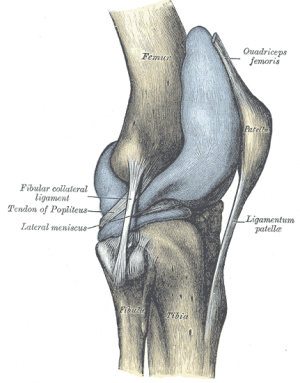Patellar Apprehension Sign: Difference between revisions
Rachael Lowe (talk | contribs) m (Text replace - '<references /> ' to '<references /> {{Template:Disclaimer}}') |
Kim Jackson (talk | contribs) (Updated categories) |
||
| (31 intermediate revisions by 7 users not shown) | |||
| Line 1: | Line 1: | ||
<div class="editorbox"> | |||
'''Original Editor''' - [[User:Alan Jit Ho Mak|Alan Jit Ho Mak]] | |||
'''Top Contributors''' - {{Special:Contributors/{{FULLPAGENAME}}}} | |||
</div> | |||
<br> | |||
|- | == Description == | ||
[[File:Knee joint.png|thumb]] | |||
Patellar apprehension sign is a physical finding in which forced lateral displacement of the [https://www.physio-pedia.com/Patella patella] produces anxiety and resistance in patients with a history of [https://www.physio-pedia.com/Patellofemoral_Instability lateral patellar instability].<ref>Ahmad CS, McCarthy M, Gomez JA, Shubin Stein BE. [https://journals.sagepub.com/doi/abs/10.1177/0363546508328113 The moving patellar apprehension test for lateral patellar instability.] The American journal of sports medicine. 2009 Apr;37(4):791-6.</ref> | |||
== Technique == | |||
The clinician will instruct the patient to be positioned in a supine or sitting position on the bench with his/her knee flexed to 30 degrees. The quadriceps should be relaxed to allow passive movements of the patella. The clinician will perform this technique by using their thumb of both hands, and pressing on the medial side of the patient's patella. | |||
The test is positive if it produces pain and apprehension. If the test is positive, take notice of the patient's facial expression, as he/she maybe surprised by the amount of lateral displacement of the patella, and may feel uncomfortable or apprehensive, as the patella reaches the maximal lateral displacement. The patient may even reach for the clinician hands or attempt to straighten his/her knee in an attempt to pull the patella back to the relative normal position.<ref>McConnell J. Rehabilitation and nonoperative treatment of patellar instability. Sports medicine and arthroscopy review. 2007 Jun 1;15(2):95-104.</ref> {{#ev:youtube|bqysF7bzpnM|300}} | |||
= | <ref>Patellar Apprehension Test Available from: http://www.youtube.com/watch?v= bqysF7bzpnM [last accessed 18/10/2020]</ref> | ||
A modified version if this test can also be performed: the [https://www.physio-pedia.com/Moving_Patellar_Apprehension_Test Moving Patellar Apprehension Test]. | |||
== | == Knee-Special Test == | ||
When a patient expresses apprehension or try to move their affected knee away from the pressure, this indicate a positive sign. This is a sound test to find out whether a patient is having symptoms for a subluxing or dislocating patella. <ref>Manske RC, Davies GJ. Examination of the patellofemoral joint. International journal of sports physical therapy. 2016 Dec;11(6):831.</ref> | |||
== References == | |||
<references /> | |||
[[Category:Special_Tests]] | |||
<references /> | [[Category:Knee - Assessment and Examination]] | ||
[[Category:Assessment]] | |||
[[Category:Knee - Special Tests]] | |||
Latest revision as of 21:51, 31 January 2021
Original Editor - Alan Jit Ho Mak Top Contributors - Alan Jit Ho Mak, Agoro Bukola Zainab, Rachael Lowe, Admin, Kim Jackson, Amanda Ager and George Prudden
Description[edit | edit source]
Patellar apprehension sign is a physical finding in which forced lateral displacement of the patella produces anxiety and resistance in patients with a history of lateral patellar instability.[1]
Technique[edit | edit source]
The clinician will instruct the patient to be positioned in a supine or sitting position on the bench with his/her knee flexed to 30 degrees. The quadriceps should be relaxed to allow passive movements of the patella. The clinician will perform this technique by using their thumb of both hands, and pressing on the medial side of the patient's patella.
The test is positive if it produces pain and apprehension. If the test is positive, take notice of the patient's facial expression, as he/she maybe surprised by the amount of lateral displacement of the patella, and may feel uncomfortable or apprehensive, as the patella reaches the maximal lateral displacement. The patient may even reach for the clinician hands or attempt to straighten his/her knee in an attempt to pull the patella back to the relative normal position.[2]
A modified version if this test can also be performed: the Moving Patellar Apprehension Test.
Knee-Special Test[edit | edit source]
When a patient expresses apprehension or try to move their affected knee away from the pressure, this indicate a positive sign. This is a sound test to find out whether a patient is having symptoms for a subluxing or dislocating patella. [4]
References[edit | edit source]
- ↑ Ahmad CS, McCarthy M, Gomez JA, Shubin Stein BE. The moving patellar apprehension test for lateral patellar instability. The American journal of sports medicine. 2009 Apr;37(4):791-6.
- ↑ McConnell J. Rehabilitation and nonoperative treatment of patellar instability. Sports medicine and arthroscopy review. 2007 Jun 1;15(2):95-104.
- ↑ Patellar Apprehension Test Available from: http://www.youtube.com/watch?v= bqysF7bzpnM [last accessed 18/10/2020]
- ↑ Manske RC, Davies GJ. Examination of the patellofemoral joint. International journal of sports physical therapy. 2016 Dec;11(6):831.







